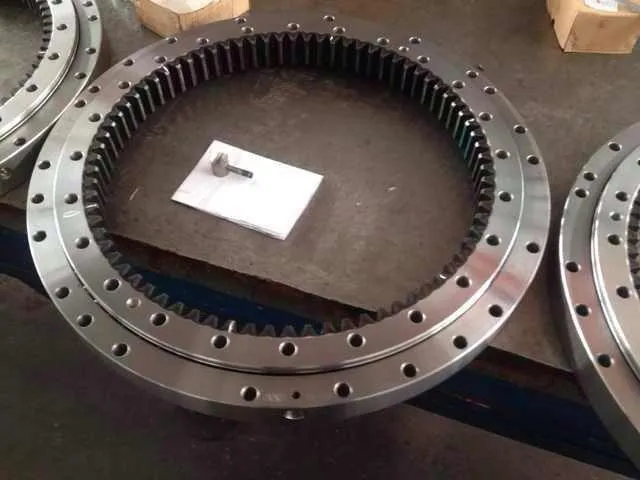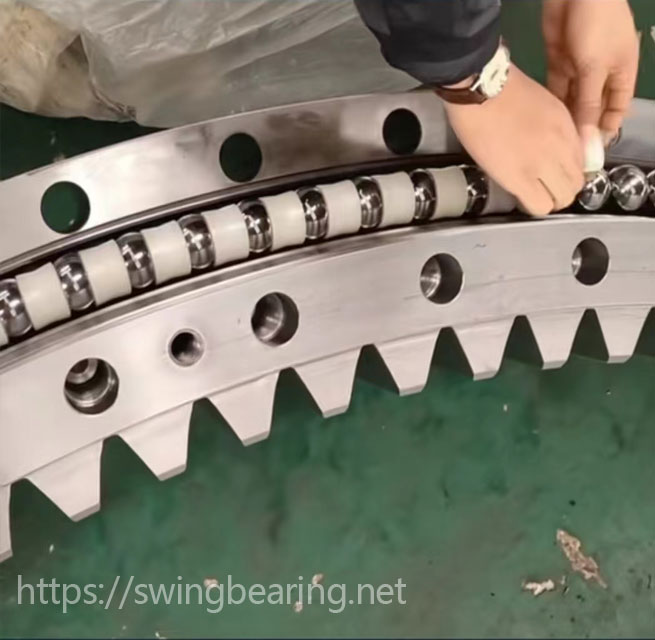
In the realm of heavy machinery and construction, the CAT 345BII Roulement de pivotement 227-6094 plays a crucial role in ensuring the smooth and efficient operation of equipment such as cranes, excavators, and other large-scale machinery. To maximize the service life and feasibility of these bearings, it is essential to select the correct size and precision, taking into account the parts used, operating conditions, and environmental factors. This blog will delve into various methods to enhance the lifespan of the CAT 345BII Swing Bearing 227-6094, as well as important precautions and considerations for its optimal use.

The CAT 345BII Swing Bearing 227-6094, which features a double row ball slewing design, is engineered to handle radial loads and combined radial loads. This type of bearing is typically paired and utilized in applications such as the front and rear wheels of automobiles, active umbrella gears, differentials, reducers, and other transmission components. Ensuring that the bearing is used in the appropriate applications helps in maintaining its structural integrity and longevity.
The rotational speed of the CAT 345BII Swing Bearing 227-6094 is another critical factor that affects its lifespan. Under proper installation and optimal lubrication conditions, the bearing’s limit speed ranges between 0.3 to 0.5 times its maximum rated speed. For best performance and extended service life, it is recommended to operate the bearing at around 0.2 times the limit speed. This precaution helps in preventing excessive wear and tear.
One of the important aspects of maintaining the CAT 345BII Swing Bearing 227-6094 is ensuring that the shaft is not inclined relative to the housing hole. Tapered roller bearings of this type generally do not tolerate any shaft inclination, which can lead to uneven load distribution and premature failure.

The operating temperature is a significant factor in the performance and durability of the CAT 345BII Swing Bearing 227-6094. Under normal load-bearing conditions, the bearing can function effectively in an ambient temperature range of -30°C to 150°C, provided there is sufficient lubrication. Using lubricants that perform well at high temperatures ensures that the bearing operates smoothly and efficiently.
Regularly checking the running condition of the CAT 345BII Swing Bearing 227-6094 is crucial for maintaining its performance and longevity. Implementing a comprehensive inspection plan can help identify early signs of wear and potential issues. Monitoring the state of the rotating disc and detecting damage early can prevent catastrophic failures and extend the bearing’s service life.
Noise is a common indicator of potential problems in bearings. A smooth and brittle sound often suggests inadequate lubrication or incorrect clearance within the bearing. Concave marks on the outer ring can lead to vibration, while scars from equipment jumping can produce noises at varying speeds. Intermittent noise may indicate damaged rolling parts, and a hissing sound often points to severe damage. Addressing these noise issues promptly can prevent further deterioration.
Selecting the right CAT 345BII Swing Bearing 227-6094 for your specific application involves considering the maximum load capacity. The double row ball slewing bearing must handle axial load, radial load, and tipping moments effectively. For applications in cranes, excavators, and other large machinery, it is vital to ensure that the bearing’s maximum load capacity is not exceeded to avoid damage.
In summary, improving the lifespan and feasibility of the CAT 345BII Swing Bearing 227-6094 involves careful consideration of its application, rotational speed, tilt angle, and operating temperature. Regular inspections, noise monitoring, and selecting the appropriate bearing for your specific needs are all crucial steps in ensuring optimal performance and longevity. By adhering to these guidelines, you can significantly enhance the efficiency and durability of your machinery.

Q1: What are the primary applications of the CAT 345BII Swing Bearing 227-6094?
A1 : The CAT 345BII Swing Bearing 227-6094 is primarily used in heavy machinery such as cranes, excavators, and large construction equipment. It is also used in automotive applications, including the front and rear wheels, active umbrella gears, differentials, and reducers.
Q2: How does the rotational speed affect the lifespan of the CAT 345BII Swing Bearing 227-6094?
A2 : The rotational speed significantly impacts the bearing’s lifespan. It is recommended to operate the bearing at around 0.2 times its limit speed to prevent excessive wear and tear, ensuring prolonged service life.
Q3: What temperature range can the CAT 345BII Swing Bearing 227-6094 operate within?
A3 : The CAT 345BII Swing Bearing 227-6094 can operate effectively within an ambient temperature range of -30°C to 150°C, provided it has sufficient lubrication.
Q4: Why is regular inspection important for the CAT 345BII Swing Bearing 227-6094?
A4 : Regular inspection is crucial to identify early signs of wear and potential issues. It helps in implementing preventive measures, avoiding catastrophic failures, and extending the bearing’s service life.
Q5: What noise indicators should be addressed to maintain the CAT 345BII Swing Bearing 227-6094?
A5 : Noise indicators such as smooth and brittle sounds, concave marks on the outer ring, intermittent noise, and hissing sounds should be promptly addressed. These noises often indicate issues like inadequate lubrication, incorrect clearance, and severe damage, which can lead to premature bearing failure.